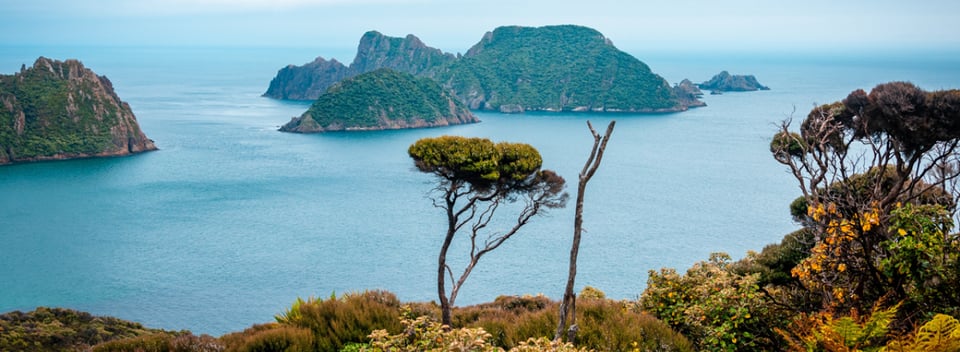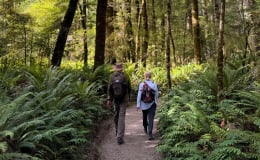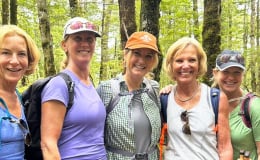
Travel like it used to be | 24 hours on Stewart Island
As you enter Invercargill airport and check-in for your flight across to Rakiura/Stewart Island it’s hard not to think this is more similar to what the Wright brothers had in mind when they started the aviation industry all those years ago. Instead of having to worry whether your toothpaste is over 100 grams or not as you disrobe through security, you are instead greeted by a friendly baggage handler who also happens to be your pilot for today’s 20-minute flight to paradise.

Soaring over the island paradise of Stewart Island.
Once safely aboard your pilot effortlessly pulls the plane into the air and within seconds you’re crossing the coastline of the South Island into the endless expanse that lies beyond. Except there is one more landmass before the ocean continues on its journey to Antarctica, and luckily for us, that is where we are headed.
Stewart Island, or Rakiura “land of the glowing skies” as it’s known to the native Maori people is the third largest island of the over 600 that make up New Zealand. Despite this it is only home to roughly 400 people and almost entirely inaccessible by road. Like most of New Zealand Rakiura was harnessed for its natural resources during colonisation, but luckily its remote location meant it was spared the same levels of deforestation and development. A visit here is like visiting the New Zealand Captain Cook discovered over 250 years ago.

Explore Stewart Island with New Zealand Trails.
Just as quickly as our flight takes off Steward Island appears from the mist ahead. Down below the ferry transports people and freight across the 32km(20 miles) Foveaux Strait that separates it from the mainland, the often rough seas making the flight the sensible choice for anyone without well-established sea legs. Soon the island's one settlement, the town of Oban comes into view, but just as quickly it gives way to the thick native bush that covers most of the island. In fact, 97% of Rakiura is protected land, the majority of which forms the Rakiura National Park.
As the plane starts its descent, a small clearing of the bush identifies itself as our runway and with the ease of someone who does this ten times a day the pilot brings us to a stop. With no sign of a terminal in sight our chariot, or minivan in this case, comes racing down the runway to collect us for the 5-minute drive into town where the terminal sits on the waterfront. Once unloaded, bags are collected at the desk which also doubles as the local post office, information centre, bowling club and golf course reception. Now it’s time for the real fun to begin.
After collecting our vehicle for our visit and some freshly packed lunches it’s off to the end of the road, a whopping 5km(3 miles) away to the magical Lee Bay, which is the gateway to the Rakiura National Park and the start of Stewart Island's Great Walk. After a picnic lunch by the beach at the end of the old telegraph line which once connected Rakiura to the mainland, we set off through the Anchor Chain archway which makes the start of the track. Native Maori people consider Stewart Island the anchor stone which holds the South Island, a great canoe, in place and this statue is part of a larger anchor chain which disappears under the sand and reappears in Bluff, the southern tip of the South Island.

A friendly welcome from a local Kaka.
Once passing through the entrance the true wonders of Rakiura/Stewart Island don’t take long to reveal themselves. Impossibly green native bush cascades down to white sand beaches and crystal clear water, a dip of the toes needed to remind yourself you're closer to the bottom of the world than the Bahamas. Before long we are greeted by the native birdsong which has sadly disappeared from much of the mainland, with some of the friendly locals flying in for a closer look at their visitors.
The track winds its way along the coast, with each small climb rewarded by a new beach or estuary to enjoy. Before long we arrive at Maori Beach, a mile-long golden sandy beach once home to the largest settlement on the island when one of the few sawmills were built here. Rusted relics contrast against the green bush offering a glimpse into life here back in the 1800s. A small campsite now fills the cleared land making a perfect spot for an afternoon swim or siesta.
At the end of the beach a swing bridge takes the track back into the bush, with the option to continue on to the Port William Hut, a beautiful lodge multi-day hikers can book as they continue on for either the 3-day Great Walk or even the 10 day Northwest Circuit of the island. For most of us though Maori beach provides the ideal spot to relax the afternoon away before meandering our way back to the trailhead.
Once back in town we check into our lovely accommodation overlooking the bay and wander down to explore Oban, the Island’s one main settlement. Despite its size, it has everything the islanders could wish for, a supermarket, fish and chip store, petrol station, museum, and most importantly, our destination, the famous South Seas Hotel and Restaurant. A Stewart Island institution, it has been the hub of the community for well over a hundred years and offers a glimpse into the lives of the locals who call Rakiura home. After a well earnt cold beer and a dinner of fresh seafood it’s back up the hill to watch the famous Rakiura sunset which gave the island its name. For those not afraid of the dark there is then a chance to head out into the bush nearby to hopefully catch a glimpse of the island's most famous residents, the Tokoeka, or Southern Brown Kiwi bird. While Rakiura/Stewart Island is home to nearly a third of the remaining population of our national bird, they are still very elusive and being nocturnal, more often heard than seen. However, with dedicated predator control by the locals, they are becoming more common around the town itself recently.

You can't beat a Stewart Island sunset.
The following morning a hearty breakfast at the South Seas Hotel is followed by a short drive to the other end of the road where our boat awaits to take us on the short journey across the bay to the jewel in the crown of Rakiura’s conservation effort, Te Wharawhara/Ulva Island.
Luckily the ocean is glassy and the boat glides across the glistening bay before dropping us off at Post Office Cove, once the main mail delivery point on the island due to its central location. When the island's mail would be delivered by a passing ship, the postman would raise a flag to let the inhabitants of the various settlements know, and before long the bay would be filled with rowboats descending to see what had arrived. It even became one of the biggest social occasions in island life with often months between each delivery.
Once ashore we are immediately greeted by one of the island's many native bird species, the Korimako/NZ Bellbird, setting the scene for a lovely morning wandering the trails which grace the island. Ulva Island has been completely cleared of any foreign pests and predators and as a result, native bird species which were almost extinct have been able to be introduced and are thriving, such as the Tieke/South Island Saddleback. No one lives on the island full time but a team of rangers and locals help to constantly set and check traps, there is even a local rat-sniffing dog who makes regular visits to make sure no unwanted visitors have hitched a ride or even swam the half-mile journey from the main island.
After spotting another half dozen or so native species enjoying their island paradise, and even sharing a peaceful stop on the beach with some local Sea lions, our boat returns to deliver us back to the airport, where a familiar face once again loads us up for the return journey across the strait.

Travel like it used to be with New Zealand Trails.
Rakiura slowly disappears into the sea mist behind us and the signs of civilization on the mainland reappear, it’s hard to believe somewhere so close can seem so far away from the rest of the world. While the hustle and bustle of modern life go on island life just ticks along, one glorious sunset after the next and you realise why many of the local residents are up to the eighth generation of their families who arrived and never left. As we bid our pilot farewell and start our journey back to Queenstown, I see everyone already checking their photos of our 24 hours there, trying to come to terms with the fact we are now back in the real world and wishing we could just turn around and do it all over again.
If you're longing to travel like the good old days, when it was less about getting the perfect shot for instagram and more about experiencing life with the locals then our all-inclusive New Zealand adventures might be just what you're looking for. If you'd like to find out more about our trips you can grab a copy of your FREE BROCHURE HERE or get in touch with us HERE - we love to chat all things New Zealand!







